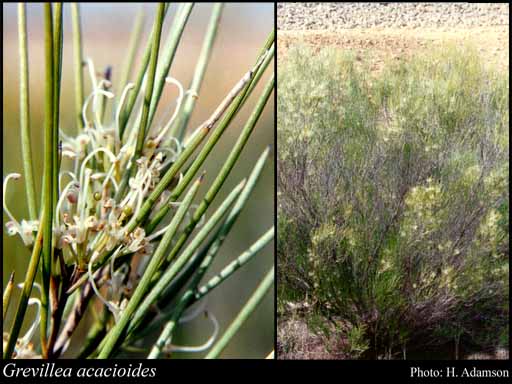- Reference
- New Names Grevillea 1 (1986)
- Conservation Code
- Not threatened
- Naturalised Status
- Native to Western Australia
- Name Status
- Current
Erect, much-branched shrub, 1-2.2 m high. Fl. white-cream-green, May to Sep (mainly Jul-Sep). Red or yellow sand, gravelly loam over granite, laterite. Sandplains.

Scientific Description
Shrubs, 1-3 m high; branchlets glabrous or hairy, not glaucous. Leaves alternate, 30-85 mm long, 1-1.5 mm wide, hairy, the hairs straight; lamina subterete, more or less the same width throughout, entire. Inflorescences axillary or terminal, green or white; pedicels 5-7 mm long. Perianth 6-8 mm long; tepals all free after flower opens, glabrous; ovary glabrous, stipitate, the stipe 1-2 mm long; pistil 9-12.5 mm long, white, pollen presenter oblique, style glabrous. Follicles glabrous, not viscid, dehiscent, 9-13 mm long. Flowers in May, July, August or September. Occurs in the Eremaean (ER) or South-west (SW) Botanical Province(s), in the Yalgoo (YAL), Murchison (MUR), Great Victoria Desert (GVD), Coolgardie (COO), Avon Wheatbelt (AW), Mallee (MAL) or Esperance Plains (ESP) IBRA subregion(s).
Distribution
- IBRA Regions
- Avon Wheatbelt, Coolgardie, Esperance Plains, Great Victoria Desert, Mallee, Murchison, Yalgoo.
- IBRA Subregions
- Eastern Goldfield, Eastern Murchison, Fitzgerald, Merredin, Shield, Southern Cross, Tallering, Western Mallee.
- Local Government Areas (LGAs)
- Bruce Rock, Coolgardie, Corrigin, Dalwallinu, Dundas, Kalgoorlie-Boulder, Koorda, Kulin, Lake Grace, Laverton, Leonora, Menzies, Merredin, Mount Magnet, Mukinbudin, Narembeen, Perenjori, Ravensthorpe, Sandstone, Westonia, Wiluna, Yalgoo, Yilgarn.